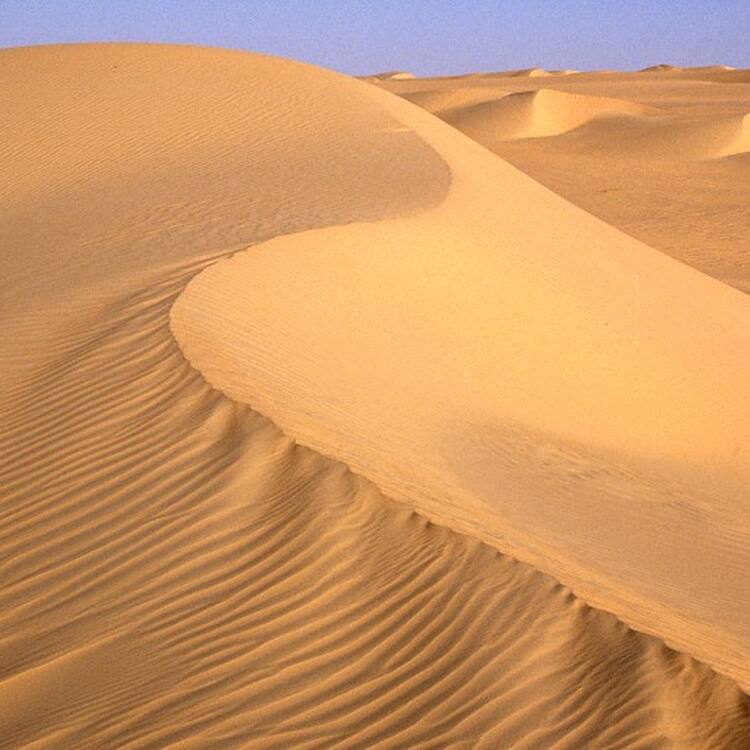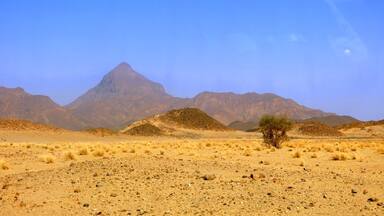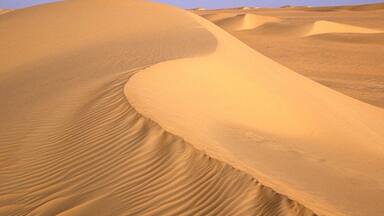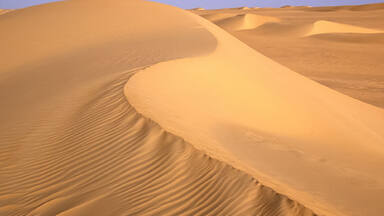Air and Ténéré Natural Reserves
Air and Ténéré Natural Reserves
This is the largest protected area in Africa, covering some 7.7 million ha, though the area considered a protected sanctuary constitutes only one-sixth of the total area. It includes the volcanic rock mass of the Aïr, a small Sahelian pocket, isolated as regards its climate and flora and fauna, and situated in the Saharan desert of Ténéré. The reserves boast an outstanding variety of landscapes, plant species and wild animals.
Description is available under license CC-BY-SA IGO 3.0
Réserves naturelles de l'Aïr et du Ténéré
C'est la plus grande aire protégée d'Afrique, avec 7,7 millions d'hectares. La zone considérée comme sanctuaire protégé n'en représente que le sixième. Elle comprend le massif éruptif de l'Aïr, îlot sahélien isolé dans le désert saharien du Ténéré par son climat, sa flore et sa faune. Les réserves possèdent un ensemble exceptionnel de paysages, d'espèces végétales et d'animaux sauvages.
Description is available under license CC-BY-SA IGO 3.0
محميتا الأيير والتينيري الطبيعيتَيْن
إنّها أكبر مساحة محميّة في أفريقيا تبلغ 7.7 مليون هكتار. فالمنطقة التي تُعتبر كمعبد محمي لا تمثل سوى السُّدس. وهي تتضمَّن كتلة الايير البركانية، وهي جزيرة صغيرة سهلانيّة منزويّة في صحراء تينيري المتميّزة بمناخها وبتشكيلة النباتات ومجموعة الحيوانات فيها. إذ تملك المحميّتان مجموعةً فريدةً من المناظر الطبيعيّة وأنواع النباتات والحيوانات البريّة.
source: UNESCO/CPE
Description is available under license CC-BY-SA IGO 3.0
阿德尔和泰内雷自然保护区
阿德尔和泰内雷自然保护区是非洲最大的自然保护区,占地约770万公顷,但整个区域只有约占面积六分之一的地区被认为真正具有保护意义。该地区包括阿德尔火山断层和小萨赫勒地区,该地区虽然位于泰内雷的撒哈拉沙漠,但是那里的气候、动物和植物却与周围地区明显不同。阿德尔和泰内雷自然保护区以拥有各异的环境、多样化的植物和野生动物而著称。
source: UNESCO/CPE
Description is available under license CC-BY-SA IGO 3.0
Природные резерваты Аир и Тенере
Это самая крупная охраняемая территория во всей Африке, площадью около 7,7 млн. га. При этом зона наиболее строгой охраны (местообитание исчезающей антилопы аддакс) занимает примерно 1/6 часть указанной площади. Резерваты включают два участка: гористый массив вулканического происхождения Аир, с более влажным климатом, разнообразными ландшафтами, и весьма богатой флорой и фауной, а также Тенере – песчаный участок пустыни Сахара.
source: UNESCO/CPE
Description is available under license CC-BY-SA IGO 3.0
Reservas naturales del Air y el Teneré
Estas reservas se extienden por una superficie de 7.700.000 hectáreas y forman la zona natural protegida más vasta de toda África, aunque el santuario propiamente dicho sólo abarca una sexta parte de esa extensión. El sitio comprende el macizo volcánico del Air, islote saheliano situado en medio del desierto sahariano del Teneré, con un clima, flora y fauna totalmente singulares. La variedad de los paisajes y las especies vegetales y animales de las reservas es excepcional.
source: UNESCO/CPE
Description is available under license CC-BY-SA IGO 3.0
アイールとテネレの自然保護区群
source: NFUAJ
Natuurreservaat Aïr en Ténéré
Source: unesco.nl
Outstanding Universal Value
Brief synthesis
The Aïr and Ténéré Natural Reserves is one of the largest protected areas in Africa, covering 7,736,000 hectares. It is the last bastion of Saharo-Sahelian wildlife in Niger. It comprises two main zones : the mountain massifs of Aïr rising up to 2000 m in altitude and the vast plain of the Ténéré desert. In the heart of a desert environment, the Aïr represents a small pocket of Sahelian plant life with Sudanese and Saharo-Mediterranean elements.
Criterion (vii): The Aïr constitutes a Sahelian enclave surrounded by a Saharian desert, thus forming a remarkable assemblage of relict ecosystems combined with mountain and plain landscapes of outstanding esthetic value and interest. The live dunes of the Ténéré rapidly modify the landscape through displacement and deposition of sand. The region contains the blue marble mountains that represent an exceptional aesthetic interest.
Criterion (ix): The Reserve of Aïr and Ténéré is the last bastion of Saharo-Sahlien wildlife in Niger. The isolation of the Aïr and the very minor human presence are the reasons for the survival in this region of numerous wildlife species that have been eliminated from other regions of the Sahara and the Sahel. The property contains a wide variety of habitats (living dunes, fixed dunes, stoney gravel desert, cliff valleys, canyons, high plateaus, water holes, etc.) necessary for the conservation of the Saharo Sahelian biological diversity.
Criterion (x): The property contains important natural habitats for the survival of the three antelopes of the Sahara Desert on IUCN's Red List of threatened species: the Dorcus gazelle (Gazella dorcas dorcas); the Leptocere gazelle (Gazella leptoceros); and the Addax (screwhorn antelope) (Addax nasomaculatus). About a sixth of the Reserve benefits from the statute of sanctuary for the protection of the Addax. The property contains important populations of species of ungulates of the Sahara and species of carnivore such as the fennec fox, Rüppells fox, and the cheetah. The massif of the Aïr also constitutes a transit zone for a large number of afrotropical and palaearctic migratory birds. In total, 40 species of mammals, 165 species of birds, 18 species of reptiles and one amphibian species have been identified in the Reserve. As concerns the flora, the steppe contains species of Acacia ehrenbergiana, Acacia raddiana, Balanites aegyptiaca, Maerua crassifolia, and at lower altitudes species of Panicum turgidum and Stipagrostis vulnerans. In the larger valleys where water in the alluvial reservoirs is plentiful, a very specific habitat has developed associating a dense ligneous stratum of doum palms, date palms, Acacia nilotica, Acacia raddiana, Boscia senegalensis, Salvadora persica, and a herbaceous stratum with among others, Stipagrostis vulnerans.
Integrity
The property is one of the largest protected areas in Africa covering a surface of 7,736,000 ha. Its central part (1,280,500ha) is listed as a strict reserve (Addax Sanctuary). As the desert species are found in very low densities, this large size is essential for their survival. In the boundaries of the Aïr mountains and the Ténéré desert, the boundaries are marked at all the principal entry points. An extension in the south-west to include a site for wildlife under certain rainfall conditions and to take into account a migration of Addax south-east to the Mt Termit region is under consideration.
Protection and management requirements
The property was inscribed on the List of World Heritage in Danger in 1992 due to political instability and dissention among the populations. The property benefits from legal protection and satisfactory management, with technical and financial support from the State and development partners. It does not have a management plan. Hunting and exploitation of wood products are forbidden in the Reserve; and access to the Addax Sanctuary is also strictly forbidden. Poaching and illegal grazing are the main threats that endanger the property. These threats are finding the beginnings of a solution with surveillance and awareness raising activities but much remains to be done to completely eliminate them. To minimize these problems, the physical presence of the management authorities in the Reserve needs to be strengthened; the respective land-use rights and access to resources by the local populations requires clarification, monitoring and surveillance of the property needs to be improved to combat the problems of poaching and the illegal extraction of natural resources and halt the collection of wood and haulm in the property for commercial purposes. The sustainable development and conservation of this property requires the strengthening of financial and technical support from the State and the development partners, in order to establish a development and management plan for the site, for efficient implementation a framework for inter-communal concertation, and to agree on the co-management of the natural resources of the property by the State and the concerned communities.



